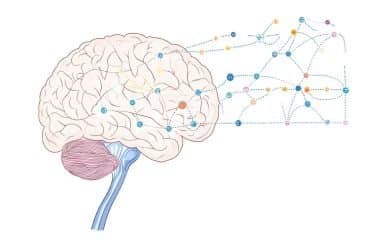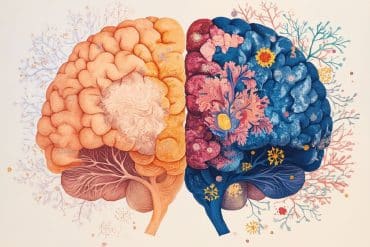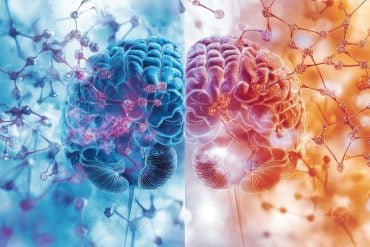Summary: According to a new study, fathers given a boost of oxytocin expressed increased activity in brain areas associated with empathy and reward when viewing photos of their small children.
Source: Emory Health Sciences.
Study looks at neural mechanisms of paternal caregiving.
Fathers given boosts of the hormone oxytocin show increased activity in brain regions associated with reward and empathy when viewing photos of their toddlers, an Emory University study finds.
“Our findings add to the evidence that fathers, and not just mothers, undergo hormonal changes that are likely to facilitate increased empathy and motivation to care for their children,” says lead author James Rilling, an Emory anthropologist and director of the Laboratory for Darwinian Neuroscience. “They also suggest that oxytocin, known to play a role in social bonding, might someday be used to normalize deficits in paternal motivation, such as in men suffering from post-partum depression.”
The journal Hormones and Behavior published the results of the study, the first to look at the influence of both oxytocin and vasopressin – another hormone linked to social bonding – on brain function in human fathers.
A growing body of literature shows that paternal involvement plays a role in reducing child mortality and morbidity, and improving social, psychological and educational outcomes. But not every father takes a “hands-on” approach to caring for his children.
“I’m interested in understanding why some fathers are more involved in caregiving than others,” Rilling says. “In order to fully understand variation in caregiving behavior, we need a clear picture of the neurobiology and neural mechanisms that support the behavior.”
Researchers have long known that when women go through pregnancy they experience dramatic hormonal changes that prepare them for child rearing. Oxytocin, in particular, was traditionally considered a maternal hormone since it is released into the bloodstream during labor and nursing and facilitates the processes of birth, bonding with the baby and milk production.
More recently, however, it became clear that men can also undergo hormonal changes when they become fathers, including increases in oxytocin. Evidence shows that, in fathers, oxytocin facilitates physical stimulation of infants during play as well as the ability to synchronize their emotions with their children.
In order to investigate the neural mechanisms involved in oxytocin and paternal behavior, the Rilling lab used functional Magnetic Resonance Imaging (fMRI) to compare neural activity in men with and without doses of oxytocin, administered through a nasal spray. The participants in the experiment were all healthy fathers of toddlers, between the ages of one and two. While undergoing fMRI brain scans, each participant was shown a photo of his child, a photo of a child he did not know and a photo of an adult he did not know.

When viewing an image of their offspring, participants dosed with oxytocin showed significantly increased neural activity in brain systems associated with reward and empathy, compared to placebo. This heightened activity (in the caudate nucleus, dorsal anterior cingulate and visual cortex) suggests that doses of oxytocin may augment feelings of reward and empathy in fathers, as well as their motivation to pay attention to their children.
Surprisingly, the study results did not show a significant effect of vasopressin on the neural activity of fathers, contrary to the findings of some previous studies on animals.
Research in prairie voles, which bond for life, for instance, has shown that vasopressin promotes both pair-bonding and paternal caregiving.
“It could be that evolution has arrived at different strategies for motiving paternal caregiving in different species,” Rilling says.”
Co-authors of the study include Ting Li (Emory Anthropology), Xu Chen (Emory Anthropology and the School of Medicine’s Department of Psychiatry and Behavioral Sciences), Jennifer Mascaro (Emory School of Medicine Department of Family and Preventive Medicine) and Ebrahim Haroon (Department of Psychiatry and Behavioral Sciences).
Funding: NIH/National Institute of Child Health and Human Development, NIH/National Center for Advancing Translational Sciences funded the study.
Source: Carol Clark – Emory Health Sciences
Image Source: NeuroscienceNews.com image is in the public domain.
Original Research: Abstract for “Intranasal oxytocin, but not vasopressin, augments neural responses to toddlers in human fathers” by Ting Li, Xu Chen, Jennifer Mascaro, Ebrahim Haroon, and James K. Rilling in Hormones and Behavior. Published online February 1 2017 doi:10.1016/j.yhbeh.2017.01.006
[cbtabs][cbtab title=”MLA”]Emory Health Sciences “How Dads Bond With Toddlers.” NeuroscienceNews. NeuroscienceNews, 17 February 2017.
<https://neurosciencenews.com/oxytocin-dad-bonding-6127/>.[/cbtab][cbtab title=”APA”]Emory Health Sciences (2017, February 17). How Dads Bond With Toddlers. NeuroscienceNew. Retrieved February 17, 2017 from https://neurosciencenews.com/oxytocin-dad-bonding-6127/[/cbtab][cbtab title=”Chicago”]Emory Health Sciences “How Dads Bond With Toddlers.” https://neurosciencenews.com/oxytocin-dad-bonding-6127/ (accessed February 17, 2017).[/cbtab][/cbtabs]
Abstract
Intranasal oxytocin, but not vasopressin, augments neural responses to toddlers in human fathers
This study investigates paternal brain function with the hope of better understanding the neural basis for variation in caregiving involvement among men. The neuropeptides oxytocin (OT) and vasopressin (AVP) are implicated in paternal caregiving in humans and other species. In a double-blind, placebo-controlled, within-subject pharmaco-functional MRI experiment, we randomized 30 fathers of 1–2 year old children to receive either 24 IU intranasal OT before one scan and placebo before the other scan (n = 15) or 20 IU intranasal AVP before one scan and placebo before the other scan (n = 15). Brain function was measured with fMRI as the fathers viewed pictures of their children, unknown children and unknown adults, and as they listened to unknown infant cry stimuli. Intranasal OT, but not AVP, significantly increased the BOLD fMRI response to viewing pictures of own children within the caudate nucleus, a target of midbrain dopamine projections, as well as the dorsal anterior cingulate (dACC) and visual cortex, suggesting that intranasal oxytocin augments activation in brain regions involved in reward, empathy and attention in human fathers. OT effects also varied as a function of order of administration such that when OT was given before placebo, it increased activation within several reward-related structures (substantia nigra, ventral tegmental area, putamen) more than when it was given after placebo. Neither OT nor AVP had significant main effects on the neural response to cries. Our findings suggest that the hormonal changes associated with the transition to fatherhood are likely to facilitate increased approach motivation and empathy for children, and call for future research that evaluates the potential of OT to normalize deficits in paternal motivation, as might be found among men suffering from post-partum depression.
“Intranasal oxytocin, but not vasopressin, augments neural responses to toddlers in human fathers” by Ting Li, Xu Chen, Jennifer Mascaro, Ebrahim Haroon, and James K. Rilling in Hormones and Behavior. Published online February 1 2017 doi:10.1016/j.yhbeh.2017.01.006






